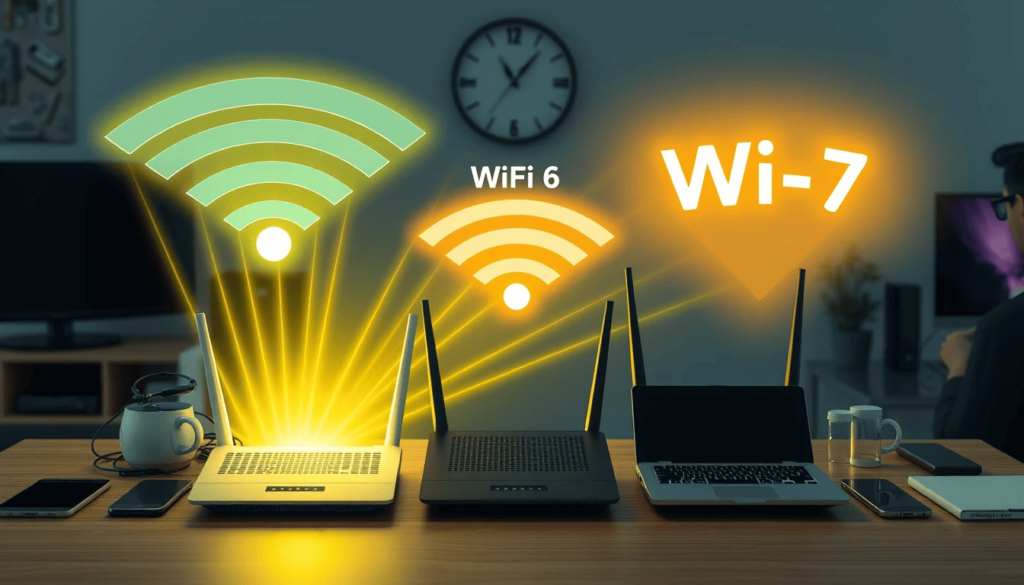WiFi 5 vs 6 vs 7: Which one is right for you?

In today's digital age, understanding the differences between various Wi-Fi standards is crucial for optimizing your home or office network. This article will explore the distinctions among Wi-Fi 5, Wi-Fi 6, and Wi-Fi 7, shedding light on their features and performance capabilities.
With the advancements in wireless technology, knowing which Wi-Fi standard suits your needs can enhance your internet experience significantly. Let's dive into the details of wifi 5 vs 6 vs 7.
- What is the difference between Wi-Fi 5, Wi-Fi 6, and Wi-Fi 7?
- What are the key features of Wi-Fi 5?
- How does Wi-Fi 6 improve wireless connectivity?
- What is Wi-Fi 6E and how does it compare to Wi-Fi 5 and 6?
- What can we expect from Wi-Fi 7 in the future?
- Should you upgrade to Wi-Fi 7?
- What are the potential limitations of Wi-Fi 5, 6, and 7?
What is the difference between Wi-Fi 5, Wi-Fi 6, and Wi-Fi 7?
The evolution from Wi-Fi 5 (802.11ac) to Wi-Fi 6 (802.11ax) and now to Wi-Fi 7 (802.11be) showcases substantial improvements in speed, efficiency, and capacity. Wi-Fi 5 can achieve speeds up to 3.5 Gbps, while Wi-Fi 6 is designed to reach 9.6 Gbps. Wi-Fi 7 aims to exceed 40 Gbps, making it the most advanced option yet.
Each standard introduces various enhancements, such as improved bandwidth utilization and better performance in congested environments. The introduction of technologies like MU-MIMO (Multi-User Multiple Input Multiple Output) in Wi-Fi 6 allows multiple devices to communicate simultaneously, enhancing overall network efficiency.
When comparing wifi 5 vs 6 vs 7, it's essential to consider your specific needs, such as the number of devices connected and the types of activities you engage in, like gaming or streaming.

What are the key features of Wi-Fi 5?
Wi-Fi 5 revolutionized wireless communication with its high throughput and efficient bandwidth management. Key features include:
- Speed: Wi-Fi 5 supports speeds up to 3.5 Gbps.
- 5 GHz Band: Operates primarily on the 5 GHz band, providing less interference.
- MU-MIMO: Allows multiple devices to connect without slowing down the network.
Despite its advantages, Wi-Fi 5 can struggle in environments with many connected devices, leading to decreased performance. Understanding these traits is crucial when assessing if Wi-Fi 5 meets your requirements.
How does Wi-Fi 6 improve wireless connectivity?
Wi-Fi 6 introduces several features that significantly enhance wireless connectivity. These include:
- Higher Speeds: Wi-Fi 6 can achieve speeds of up to 9.6 Gbps, almost tripling the capability of its predecessor.
- OFDMA: Orthogonal Frequency Division Multiple Access improves efficiency by allowing multiple users to share channels simultaneously.
- Improved Range: Offers better coverage in crowded areas, making it ideal for public spaces.
These improvements make Wi-Fi 6 a solid choice for households with numerous devices, ensuring smooth streaming and gaming experiences. This is particularly relevant when evaluating wifi 5 vs 6 vs 7.
What is Wi-Fi 6E and how does it compare to Wi-Fi 5 and 6?
Wi-Fi 6E is an extension of Wi-Fi 6, utilizing the 6 GHz band in addition to the existing 2.4 GHz and 5 GHz bands. This new band allows for more channels, reducing congestion and interference. Key differences include:
- Additional Band: The 6 GHz band offers increased bandwidth and less interference.
- More Devices: Supports a higher number of devices without compromising speed.
- Better Performance: Enhances performance in dense environments, making it ideal for smart homes.
When comparing Wi-Fi 6E to Wi-Fi 5 and 6, the advantages are clear, especially for users requiring high performance in busy settings.
What can we expect from Wi-Fi 7 in the future?
Wi-Fi 7 is set to redefine wireless technology with features like:
- Multi-Link Operation (MLO): This allows devices to connect to multiple bands simultaneously, improving reliability and speed.
- Extreme Speeds: Expected to achieve speeds exceeding 40 Gbps.
- Improved Latency: Designed for applications requiring real-time data transfer, such as augmented reality.
The potential of Wi-Fi 7 is immense, positioning it as a game-changer for various industries, particularly gaming, streaming, and smart home applications.
Should you upgrade to Wi-Fi 7?
Upgrading to Wi-Fi 7 may be beneficial depending on your current network setup and usage. If you have multiple devices, engage in high-bandwidth activities, or anticipate needing more speed in the future, the upgrade could be worthwhile.
However, consider the following factors:
- Device Compatibility: Ensure your devices support the new standard.
- Current Needs: Assess whether your current Wi-Fi meets your demands.
- Cost: Weigh the expense of upgrading against the benefits.
Evaluating these elements will help you determine if moving to Wi-Fi 7 is the right choice for you.
What are the potential limitations of Wi-Fi 5, 6, and 7?
While each standard offers distinct advantages, they also come with limitations:
- Wi-Fi 5: Can struggle in environments with many devices, leading to slower speeds.
- Wi-Fi 6: While significantly better, it may still face challenges in extremely congested areas.
- Wi-Fi 7: Early adoption may face compatibility issues with existing devices.
Understanding these limitations is vital for making an informed decision about your network setup. Each standard has its strengths and weaknesses, which should be considered based on your specific needs.
For more insights on this topic, you can watch this comprehensive video comparison:
In conclusion, understanding the nuances of wifi 5 vs 6 vs 7 is crucial for optimizing your wireless experience. Each standard has unique features and benefits, making it essential to evaluate your specific requirements before making an upgrade decision.

Deja una respuesta